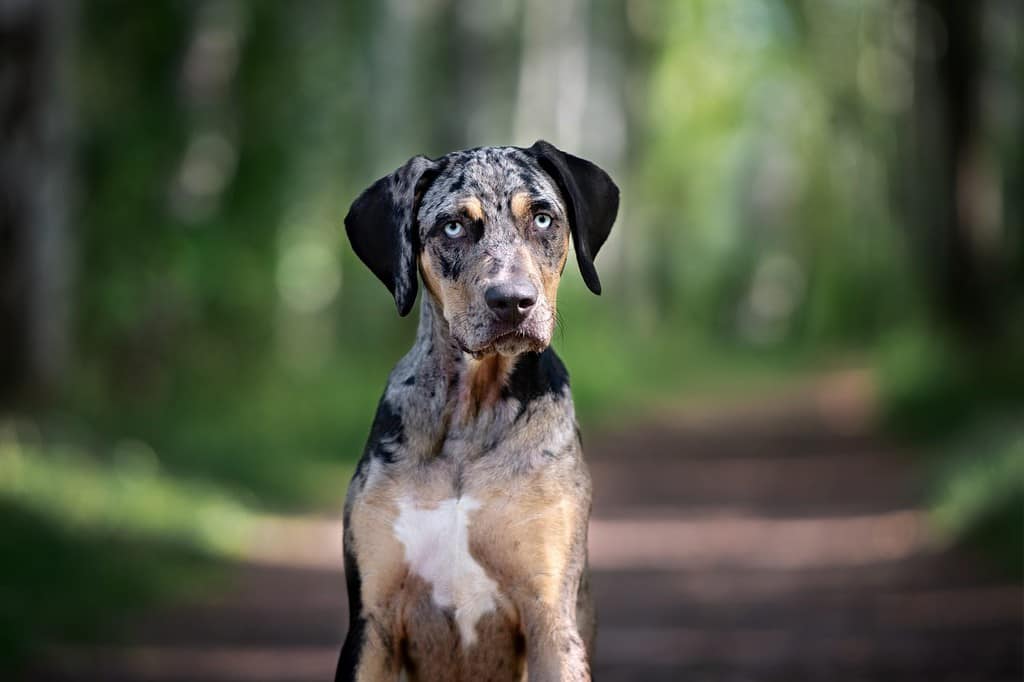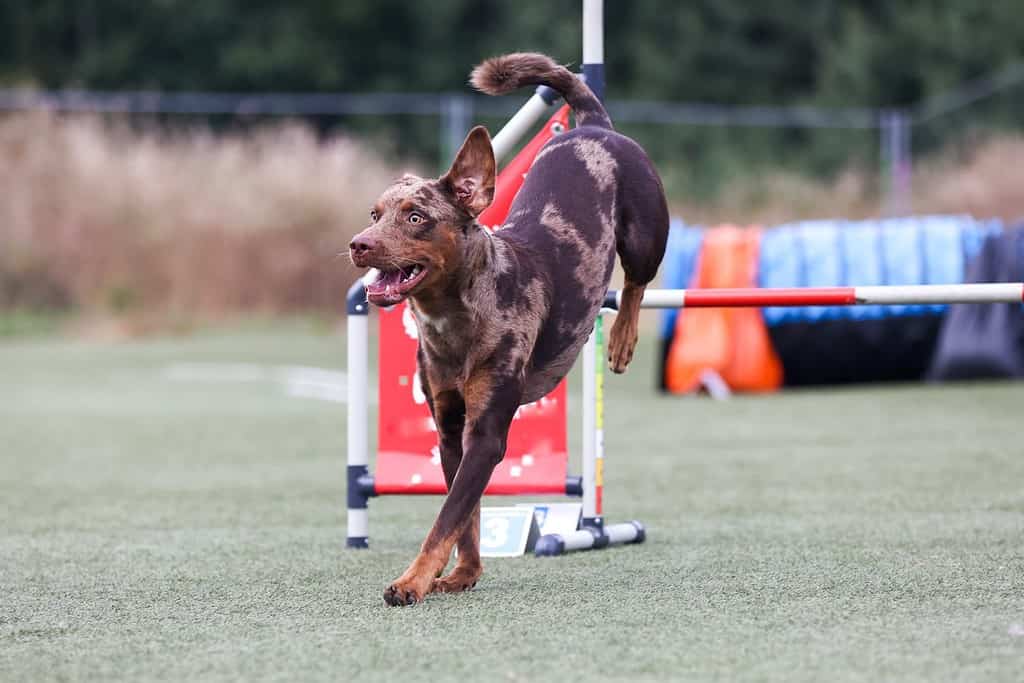The Catahoula leopard dog is a breed that originates in Louisiana, where it is the state dog. These loyal and energetic dogs were originally bred for hunting and herding, but they also make good companions. The “leopard” part of their name comes from the unique pattern of spots on dogs of this breed with the merle pattern. “Catahoula” comes from a Choctaw word meaning “sacred lake.”
Catahoula Leopard Dog Growth and Weight Chart by Age
While individual dogs can vary in size, this chart provides a general idea of what to expect.
| Age | Weight |
| Birth | 1-3 pounds |
| 1 month | 5-7 pounds |
| 2 months | 10-15 pounds |
| 3 months | 19-35 pounds |
| 4 months | 35-45 pounds |
| 5 months | 45-55 pounds |
| 6 months | 50-65 pounds |
| 7 months | 57-70 pounds |
| 8 months | 60-80 pounds |
| 10 months | 65-85 pounds |
| 12 months | 65-90 pounds |
| 18 months | 65-95 pounds |
When Will My Catahoula Leopard Dog Stop Growing?
Catahoula Leopard dogs become full-grown at around 12 to 18 months old. Individual dogs vary in how fast they grow. Females tend to reach their adult size faster than males.
To ensure your dog is growing healthily, be sure to give them enough food. An adult Catahoula Leopard dog should eat three to five cups of dry food a day, divided into two separate meals. Puppies will eat less, with the exact amount depending on their age and weight. Puppies should also eat more often, with their food divided into three or four separate meals. Dogs of all ages should have a constant supply of water to prevent dehydration.
Regular vet checkups can also help ensure your dog is growing healthily. An adult Catahoula Leopard dog will need to go to the vet once a year. Senior dogs should go to the vet twice a year, and puppies will need more frequent visits, about every three to four weeks. These extra visits are mainly for vaccinations, which are important for protecting your puppy from disease.
How Big Will My Catahoula Leopard Dog Be When They’re Fully Grown?
A fully grown Catahoula leopard dog weighs 50 to 90 pounds and is 22 to 24 inches tall and 32 to 41 inches long. The size of individual dogs can vary based on genetics and diet.
When Should My Catahoula Leopard Dog Be Spayed or Neutered?
There is a lot of debate over the best age to spay or neuter a Catahoula Leopard Dog. Some people recommend neutering male dogs as soon as they reach puberty to prevent health and behavior problems as soon as possible. However, most Catahoula Leopard dog breeders recommend waiting until a dog is 16 to 18 months old to neuter him. This is due to concerns that neutering too early will stunt a dog’s growth. Neutering a dog reduces the risk of testicular cancer and will reduce aggressive or territorial behavior.
There is also debate over the best age to spay female dogs. A female Catahoula Leopard dog will first go into heat at around 10 to 12 months old. Some people think it is healthier for a dog to be spayed before her first heat, while others think it is healthier to wait until after. Spaying a dog reduces the risk of breast cancer and uterine infections. For a dog of either sex, it is best to ask your vet for advice on the best time to spay or neuter, because every individual dog is different.
When Should My Catahoula Leopard Dog Be House Broken?
You can start house training your Catahoula Leopard dog as soon as you bring them home, or at about three months old. Start by bringing your puppy outside after meals and playtime, giving them ample opportunities to go to the bathroom outside. You can also look for signs that your puppy needs to go to the bathroom, such as sniffing around in search of a good spot, and take them outside whenever they show these signs. Praise your puppy, possibly offering a small treat, when they successfully go outside. Do not scold or punish your puppy for going indoors. This can unintentionally condition them to avoid going to the bathroom in front of you. Remember that consistency and patience are key when house training any dog.
When Should My Catahoula Leopard Dog Stop Eating Puppy Food?
As a large breed, Catahoula Leopard dogs can start transitioning from puppy food to adult food at around 12 to 15 months old, depending on your dog’s size and activity level. Gradually transition your dog by mixing adult food with puppy food rather than switching overnight. Switching to adult food too early or too late can impact your dog’s growth and development. However, it is generally better to feed puppy food for too long than not long enough.
When Will My Catahoula Leopard Dog Start Losing Teeth?
Catahoula Leopard dogs start losing teeth at around three to four months old. Their adult teeth finish growing when they are around seven months old.
Teething can be uncomfortable for a dog, so during this phase, many dogs chew to ease the discomfort. If your dog is teething, provide them with safe things they can chew on instead of your belongings. This can include soft or rubber chew toys. Do not provide hard toys or bones, as they may damage your dog’s teeth. Chewing on cold things can especially help a dog relieve discomfort, so try putting a rubber toy or a wet towel or dishrag into the freezer. You can also give your dog frozen foods such as carrots, bagels, or fruit. Do not give your dog ice cubes, as they are hard enough to damage a dog’s teeth. Supervise your puppy’s chewing behavior to ensure that it is not harming them. Remove toys that are falling apart, as swallowing part of a toy can be harmful to a dog’s health.
When Should I Start Training My Catahoula Leopard Dog?
It is best to start training your Catahoula Leopard dog as soon as possible. These dogs can be difficult to train because of their independent nature. Therefore, it is beneficial to start with the basics of training at a young age.
Socialization training can start early. This involves exposing your puppy to a variety of new people, animals, places, and things. Socialization training will get your dog used to new experiences so they won’t get overly excited or nervous whenever they see something new. Rewarding or praising calm behavior in new situations will help get the message across that new experiences are normal and nothing to fear.
More formal training should be introduced gradually as your puppy gets older. At seven weeks old, you can teach your puppy to recognize the words “yes” and “no,” as well as crate training. At eight weeks old, you can reinforce calm behavior and tolerance of handling, while discouraging biting and jumping on people or furniture. At ten weeks, you can train your puppy to walk on a leash and to come when called. At twelve weeks, you can teach your puppy “sit” and other simple commands.
Catahoula Leopard dogs are working dogs and have been trained for hunting, herding, search and rescue, and as service and therapy dogs. As working dogs, Catahoulas require lots of mental stimulation and do best when they have a job. If you cannot involve your Catahoula in a formal activity such as agility training, be sure to give them lots of exercise and provide them with mentally stimulating games and activities.
What Commands Should I Teach My Catahoula Leopard Dog First?
You can teach your Catahoula Leopard dog the same basic commands you would teach any other dog. Here are some particularly useful commands.
Sit: This is a good command to teach first because it is easy to train. Training your dog to sit on command will allow you to quickly stop harmful behaviors and get your dog’s attention.
Stay: This command is often paired with “sit” or “down.” It will get your dog to stay still longer in a situation where harmful behaviors are likely.
Come: This command trains your dog to return to you, allowing you to let them off-leash and reliably get them back.
Leave It: This command instructs your dog to ignore an object, which can prevent them from eating dropped food or rolling in a mess.
Down (or Lie Down): Laying down can have a calming effect on a dog, so this command can calm your dog in stressful situations.
Heel: This command instructs your dog to stay by your side, which can make it easier to walk them on a leash.
Drop It: This command instructs your dog to drop an object in their mouth. It can used to stop your dog from eating something harmful or chewing on your belongings.
Remember that positive reinforcement is the best way to train any dog.
Common Health Issues Your Catahoula Leopard Dog May Experience
Like any breed, Catahoula Leopard dogs may run into health issues as they get older. Some of the most common health issues for this breed are hip dysplasia, deafness, eye issues, and cancer.
Hip Dysplasia: This is a genetic disease common in large purebred dogs, including Catahoula Leopard dogs. It causes the hip joints to form incorrectly, which can lead to arthritis. Elbow and shoulder dysplasia can also occur.
Deafness: Dogs can experience both genetic and acquired deafness. In Catahoula Leopard dogs, hereditary deafness can be linked to certain fur and eye colors.
Eye Issues: Catahoula Leopard dogs can experience a variety of genetic or acquired eye issues. Some of these issues can lead to blindness if left untreated.
Cancer: All dogs have a risk of getting cancer as they age. Some types of cancer can be treated with surgery or chemotherapy if they are caught early enough. Skin cancer is especially common in Catahoula Leopard dogs.
Frequent vet visits can help inform you of health issues and allow you to seek treatment.
Pictures of Catahoula Leopard Dog as Puppies

Catahoula Leopard dogs with the merle coloration have an intricate pattern of spots.
©iStock.com/Wirestock

Catahoula Leopard dogs are very active and require lots of mental stimulation.
©otsphoto/Shutterstock.com

No matter how small, Catahoula leopards require a lot of space for running, playing, and exercise.
©Zuzule/Shutterstock.com
Pictures of Catahoula Leopard Dog at 6 Months

At six months old, a Catahoula Leopard dog weighs about 50-65 pounds.
©otsphoto/Shutterstock.com
Pictures of Fully Grown Catahoula Leopard Dog

Although originally bred for herding cattle and other livestock, this breed makes for a great family dog as well.
©Eudyptula/Shutterstock.com

Catahoula Leopard dogs excel when given a job, such as agility training.
©Lisjatina/Shutterstock.com
Other Dog Breeds Similar to Catahoula Leopard Dog
Australian Shepherd: This breed comes in similar colors to the Catahoula Leopard Dog, and is also fast, intelligent, and highly trainable.
Australian Cattle Dog: This breed comes in the merle patterns for which the Catahoula Leopard dog is known. It also has a long lifespan and a low-maintenance coat.
American Bulldog: Like the Catahoula Leopard dog, this breed has a history of being used to round up wild cattle. It also has a short coat with low shedding and a family-friendly temperament.
The photo featured at the top of this post is © everydoghasastory/Shutterstock.com
Ready to discover the top 10 cutest dog breeds in the entire world?
How about the fastest dogs, the largest dogs and those that are -- quite frankly -- just the kindest dogs on the planet? Each day, AZ Animals sends out lists just like this to our thousands of email subscribers. And the best part? It's FREE. Join today by entering your email below.
Thank you for reading! Have some feedback for us? Contact the AZ Animals editorial team.






